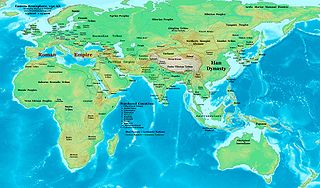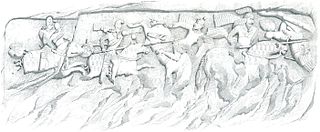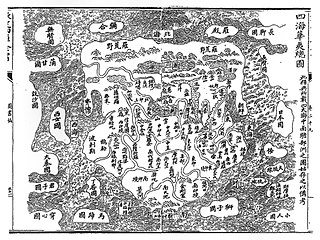
The 50s decade ran from January 1, 50, to December 31, 59. It was the sixth decade in the Anno Domini/Common Era, if the nine-year period from 1 AD to 9 AD is considered as a "decade".

The 100s decade ran from January 1, 100, to December 31, 109.
AD 58 (LVIII) was a common year starting on Sunday of the Julian calendar. At the time, it was known as the Year of the Consulship of Caesar and Messalla. The denomination AD 58 for this year has been used since the early medieval period, when the Anno Domini calendar era became the prevalent method in Europe for naming years.

AD 100 (C) was a leap year starting on Wednesday of the Julian calendar. In the Roman Empire, it was sometimes referred to as year 853 ab urbe condita, i.e., 853 years since the founding of Rome in 753 B.C. The denomination AD 100 for this year has been used since the early medieval period, when the Anno Domini calendar era became the prevalent method in Europe for naming years.
The 190s decade ran from January 1, 190, to December 31, 199.
Year 105 (CV) was a common year starting on Wednesday of the Julian calendar. At the time, it was known as the Year of the Consulship of Candidus and Iulius. The denomination 105 for this year has been used since the early medieval period, when the Anno Domini calendar era became the prevalent method in Europe for naming years.
Year 147 (CXLVII) was a common year starting on Saturday of the Julian calendar. At the time, it was known as the Year of the Consulship of Messalinus and Largus. The denomination 147 for this year has been used since the early medieval period, when the Anno Domini calendar era became the prevalent method in Europe for naming years.
Year 166 (CLXVI) was a common year starting on Tuesday of the Julian calendar. At the time, it was known as the Year of the Consulship of Pudens and Pollio. The denomination 166 for this year has been used since the early medieval period, when the Anno Domini calendar era became the prevalent method in Europe for naming years.

This article concerns the 200 BC decade, that lasted from 209 BC to 200 BC.
The 220s decade ran from January 1, 220, to December 31, 229.
Year 191 (CXCI) was a common year starting on Friday of the Julian calendar. At the time, it was known as the Year of the Consulship of Apronianus and Bradua. The denomination 191 for this year has been used since the early medieval period, when the Anno Domini calendar era became the prevalent method in Europe for naming years.

Year 208 (CCVIII) was a leap year starting on Friday of the Julian calendar. At the time, it was known as the Year of the Consulship of Aurelius and Geta. The denomination 208 for this year has been used since the early medieval period, when the Anno Domini calendar era became the prevalent method in Europe for naming years.

Year 224 (CCXXIV) was a leap year starting on Thursday of the Julian calendar. At the time, it was known as the Year of the Consulship of Iulianus and Crispinus. The denomination 224 for this year has been used since the early medieval period, when the Anno Domini calendar era became the prevalent method in Europe for naming years.
Year 221 BC was a year of the pre-Julian Roman calendar. At the time it was known as the Year of the Consulship of Asina and Rufus/Lepidus. The denomination 221 BC for this year has been used since the early medieval period, when the Anno Domini calendar era became the prevalent method in Europe for naming years.
Year 208 BC was a year of the pre-Julian Roman calendar. At the time it was known as the Year of the Consulship of Marcellus and Crispinus. The denomination 208 BC for this year has been used since the early medieval period, when the Anno Domini calendar era became the prevalent method in Europe for naming years.
Year 209 BC was a year of the pre-Julian Roman calendar. At the time it was known as the Year of the Consulship of Verrucosus and Flaccus. The denomination 209 BC for this year has been used since the early medieval period, when the Anno Domini calendar era became the prevalent method in Europe for naming years.
Year 226 BC was a year of the pre-Julian Roman calendar. At the time it was known as the Year of the Consulship of Messalla and Fullo. The denomination 226 BC for this year has been used since the early medieval period, when the Anno Domini calendar era became the prevalent method in Europe for naming years.
Year 232 BC was a year of the pre-Julian Roman calendar. At the time it was known as the Year of the Consulship of Lepidus and Melleolus. The denomination 232 BC for this year has been used since the early medieval period, when the Anno Domini calendar era became the prevalent method in Europe for naming years.
Year 239 BC was a year of the pre-Julian Roman calendar. At the time it was known as the Year of the Consulship of Turrinus and Falto. The denomination 239 BC for this year has been used since the early medieval period, when the Anno Domini calendar era became the prevalent method in Europe for naming years.

Daqin (Chinese: 大秦; pinyin: Dàqín; Wade–Giles: Ta4-ch'in2; alternative transliterations include Tachin, Tai-Ch'in) is the ancient Chinese name for the Roman Empire or, depending on context, the Near East, especially Syria. It literally means "great Qin"; Qin (Chinese: 秦; pinyin: Qín; Wade–Giles: Ch'in2) being the name of the founding dynasty of the Chinese Empire. Historian John Foster defined it as "the Roman Empire, or rather that part of it which alone was known to the Chinese, Syria". Its basic facets such as laws, customs, dress, and currency were explained in Chinese sources. Its medieval incarnation was described in histories during the Tang dynasty (618–907 AD) onwards as Fulin (Chinese: 拂菻; pinyin: Fúlǐn), which Friedrich Hirth and other scholars have identified as the Byzantine Empire. Daqin was also commonly associated with the Syriac-speaking Nestorian Christians who lived in China during the Tang dynasty.






